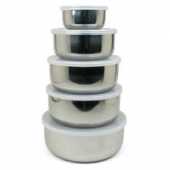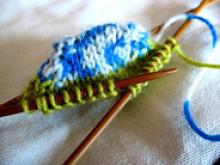Knitting Socks Toe-Up: Pros and Cons
Knitting Socks Toe-Up: Pros and Cons
If you ever want to start a really nasty fight among a bunch of knitters, simply assert a firm opinion on which is the "right" way to knit socks: toe-up or top-down. Every sock knitter develops their own preference on the matter, but the truth is that there are advantages and disadvantages to each.
As for myself, I started out knitting socks top-down, and knit many pairs that way. Then I managed to work out a toe-up pattern that I liked, and have knit them this way ever since. I guess you could say I'm bi-socks-ual.
Toe-Up: Pros
People always say that the good thing about knitting from the toe up is that "you can try it on as you go." This statement always puzzled me, because it is so clearly untrue. I even took photos of myself trying on my top-down sock, to prove it!
Turns out what they mean is, "You don't have to do any math. Just start increasing at the toe, and stop when it's big enough." This is similar in concept to the raglan sweater method where you keep increasing at the raglans and stop increasing when the sweater fits.
Personally, I don't mind doing the math. I find it easier than constantly trying on the little bit of sock and second-guessing myself.
The real benefit to the toe-up sock is that you can knit every last little bit of yarn. This lets you maximize the yardage in a precious skein of beautiful sock yarn.
This also keeps me from cutting my cuffs short because I'm bored with knitting them, and I start getting anxious about running out of yarn. I knit a lot of crew length socks when I worked top-down.
(If you have only one giant skein of sock yarn, you will need to divide it in half. To do this, wind the whole skein into a cake. Then wind off half that cake into a second cake, weighing it as you go, until the first cake is down to 50 grams. Now wind the first cake into a proper cake again, and you're set. This would be a huge pain, if the process of winding yarn into cakes wasn't so awesome.)
At the end, I like the fact that you can use a stretchy cast off at the cuff.
Toe-Up: Cons
The bewildering variety of toe-up cast ons can be off-putting, to say the least. Turkish, Magic 8, Invisible, Provisional! Furthermore, techniques for working the toe can easily leave a knitter stymied.
(Here is my personal favorite method: hold two DPNs together. Using the long-tail cast-on method, cast on a stitch onto needle 1. Then cast stitch 2 onto needle 2. It's that easy! Simply alternate casting on stitches until you have the right number.
Wrestle these stitches onto 4 needles, then increase at the 4 corners until you have the full number of stitches. Voila! )
The second common objection is the heel. I'm a heel flap girl, which is why I was excited when someone pointed out the heel that Cookie A. uses in her Baudelaire Socks pattern. It basically creates a mock heel flap, using a quick series of short rows. I use this exact same heel for every pair of socks now.
As for myself, I started out knitting socks top-down, and knit many pairs that way. Then I managed to work out a toe-up pattern that I liked, and have knit them this way ever since. I guess you could say I'm bi-socks-ual.
Toe-Up: Pros
People always say that the good thing about knitting from the toe up is that "you can try it on as you go." This statement always puzzled me, because it is so clearly untrue. I even took photos of myself trying on my top-down sock, to prove it!
Turns out what they mean is, "You don't have to do any math. Just start increasing at the toe, and stop when it's big enough." This is similar in concept to the raglan sweater method where you keep increasing at the raglans and stop increasing when the sweater fits.
Personally, I don't mind doing the math. I find it easier than constantly trying on the little bit of sock and second-guessing myself.
The real benefit to the toe-up sock is that you can knit every last little bit of yarn. This lets you maximize the yardage in a precious skein of beautiful sock yarn.
This also keeps me from cutting my cuffs short because I'm bored with knitting them, and I start getting anxious about running out of yarn. I knit a lot of crew length socks when I worked top-down.
(If you have only one giant skein of sock yarn, you will need to divide it in half. To do this, wind the whole skein into a cake. Then wind off half that cake into a second cake, weighing it as you go, until the first cake is down to 50 grams. Now wind the first cake into a proper cake again, and you're set. This would be a huge pain, if the process of winding yarn into cakes wasn't so awesome.)
At the end, I like the fact that you can use a stretchy cast off at the cuff.
Toe-Up: Cons
The bewildering variety of toe-up cast ons can be off-putting, to say the least. Turkish, Magic 8, Invisible, Provisional! Furthermore, techniques for working the toe can easily leave a knitter stymied.
(Here is my personal favorite method: hold two DPNs together. Using the long-tail cast-on method, cast on a stitch onto needle 1. Then cast stitch 2 onto needle 2. It's that easy! Simply alternate casting on stitches until you have the right number.
Wrestle these stitches onto 4 needles, then increase at the 4 corners until you have the full number of stitches. Voila! )
The second common objection is the heel. I'm a heel flap girl, which is why I was excited when someone pointed out the heel that Cookie A. uses in her Baudelaire Socks pattern. It basically creates a mock heel flap, using a quick series of short rows. I use this exact same heel for every pair of socks now.
Photo credit: Flickr/sharkseason



